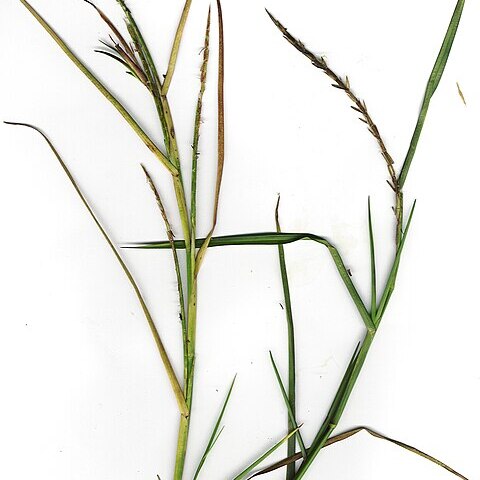Perennial, or sometimes annual. Culms loosely tufted to decumbent or stoloniferous, rooting at lower nodes, ascending up to 1.6 m tall, nodes glabrous. Leaf sheaths loose, compressed, keeled, usually shorter than internodes, glabrous except near mouth; leaf blades linear, 5–25 × 0.3–0.6 cm, acute; ligule ca. 0.3 mm. Racemes solitary or several per node, 5–10 cm, semicylindrical, articulation line oblique, tardily disarticulating. Sessile spikelet longer than adjacent internode, 5–7 mm; callus triangular, 0.8–2 mm; lower glume elliptic-oblong, leathery, flat on back, often with subapical constriction, apex obtuse to emarginate; upper glume papery, adnate to rachis, 4–7 mm, apex obtuse to acute; lower floret 3.5–5.2 mm; upper floret 3.2–4.6 mm. Pedicelled spikeletnarrowly lanceolate, lower glume acute, upper glume acuminate. 2n = 20, 36.
Stoloniferous perennial; culms up to 2.5 m. long and 2–4 mm. in diameter, prostrate and rooting at the nodes below.. Leaf-blades flat, 5–15 cm. long, 3–4 mm. wide.. Racemes 4–10 cm. long, mostly borne singly in the axils and exserted from the axillary sheath.. Sessile spikelet elliptic-oblong with a triangular callus; lower glume 4–6 mm. long, with or without a constriction near the apex, obtuse to emarginate; upper glume obtuse to acute.. Pedicelled spikelet narrowly triangular, 4–6 mm. long, truncate at the base without a callus, subacute to acute at the tip.
Erect or sprawling perennial to over 1 m tall, rooting at lower nodes. Leaves linear, flat; ligule a fringed membrane. Inflorescence often difficult to distinguish from rest of plant, leafy with many single racemes or a solitary raceme subtended by the uppermost leaf. Spikelets 5-7 mm long, paired in a sessile and pedicellate combination of dissimilar spikelets, the sessile spikelets embedded in the axis and the pedicellate ones not-sunken, dorsally compressed, awnless, 2-flowered; glumes as long as spikelet.
A rust-red perennial, 300-1500 mm high, mat forming; rhizomes and stolons present. Leaf blade 50-150 x 6 mm, flat, becoming twisted like a corkscrew when old. Inflorescence culm-like, raceme very narrowly cylindrical, 3-6 mm long. Sessile spikelet 4-7 mm long; lower glume obtuse to emarginate; upper glume obtuse to acute; callus triangular; anther 2.4-3.0 mm long. Pedicelled spikelet without a callus.
Perennial; up to 1.5 m high; rust-red; rhizomatous; stoloniferous. Leaf blades up to 50-150 x 6 mm. Flowers: in a complex; leafy; false panicle; racemes very narrowly cylindrical; spikelets sunken; sessile or pedicellate; 5-7 mm long; sessile spikelet glabrous; lower glume without oil streaks along keel.
A grass. It keeps growing from year to year. It is branched and forms dense tangled masses. It spreads by underground stems or rhizomes. It can grow 1.5 m tall. The flower spikes occur singly at the top of the stems. The spikelets are pressed close to the axis.
Perennial, rhizomatous and stoloniferous, up to 1.5 m high, rust-red. Leaf blades 50-150 mm long, up to 6 mm wide. Spikelets (sessile and pedicellate) 5-7 mm long. Racemes very narrowly cylindrical, culm-like, spikelets sunken.
Sessile spikelet elliptic-oblong, with a triangular callus; inferior glume 4–6 mm long, with or without a constriction near the apex, obtuse to emarginate at the apex; superior glume obtuse to acute at the apex.
Pedicelled spikelet narrowly triangular, 4–6 mm long, truncate at the base and without a callus, subacute to acute at the apex.
Stoloniferous perennial; culms up to 250 cm long and 2–4 mm in diameter, prostrate and rooting at the nodes below.
Erect or sprawling perennial to over 1 m. Leaves linear. Spikelets in a simple spike, embedded in jointed axis.
Racemes 4–10 cm long, mostly borne singly in the axils and exserted from the axillary sheath.
The culms ascending from a decumbent rooting base
Leaf laminas 5–15 cm × 3–4 mm, flat.
Perennial up to 1·6 m. high


